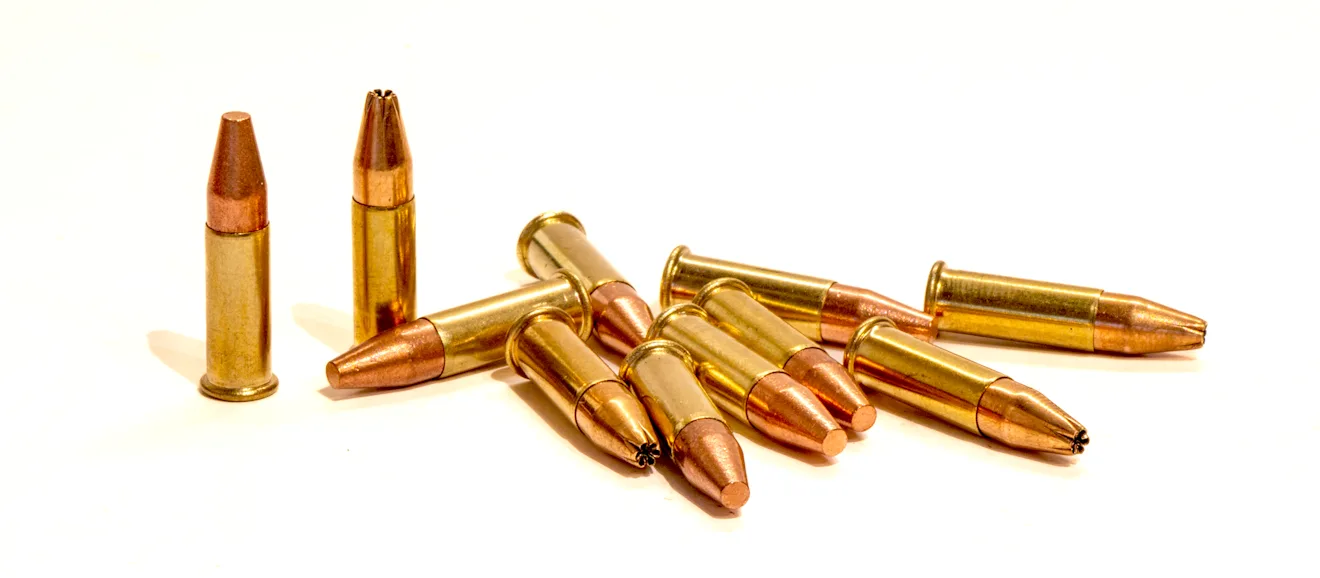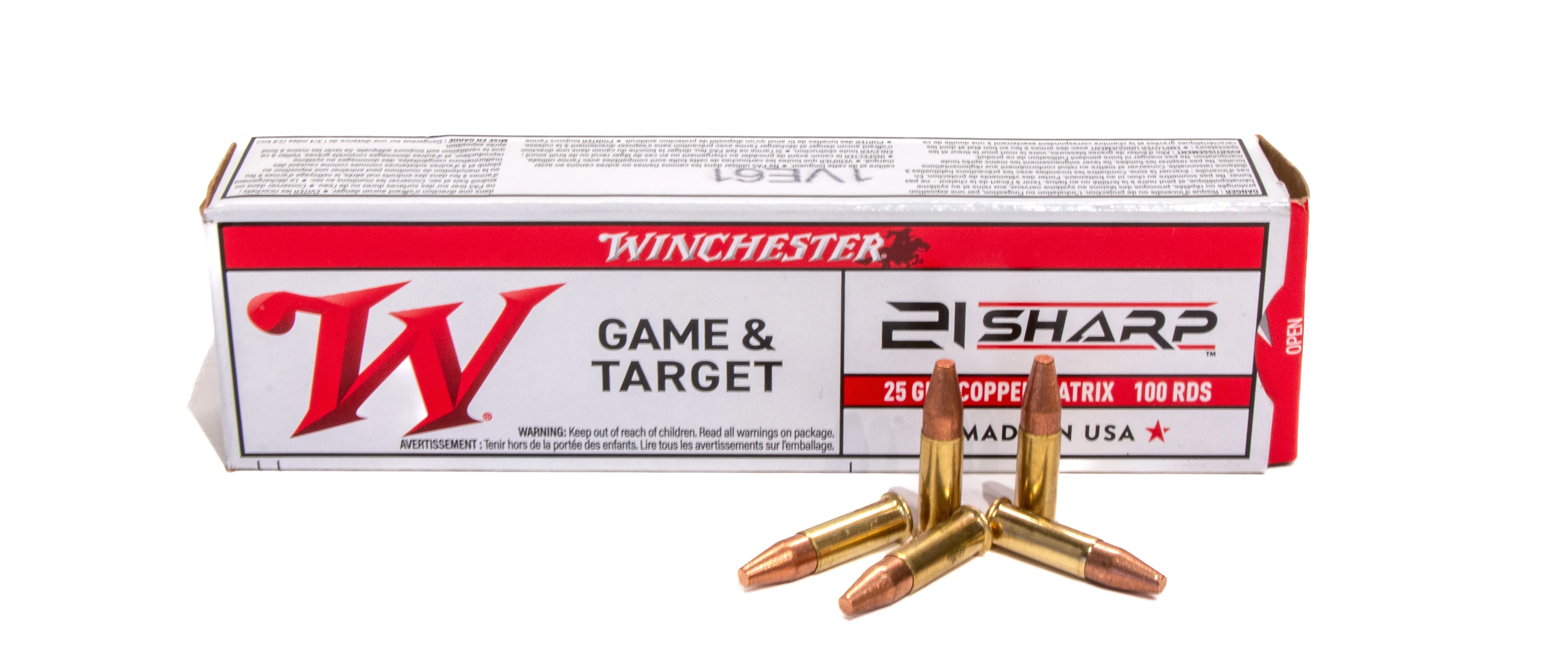Fortune favors the bold, they say, and Winchester's latest cartridge introduction is about as bold as it gets in the rifle-ammo world. The brand-new 21 Sharp rimfire cartridge is meant to be an improvement on the great 22 Long Rifle. I know, many of you will say that there's no way to improve the 22 LR. After all, we’ve been shooting it and manufactures have been perfecting it for nearly 140 years. But the truth is that the 22 Long Rifle cartridge has an inherent design flaw, and, ironically, the technology to correct the problem has been around longer than the cartridge. Winchester—give them credit—has finally done something about it.
The question, of course, is whether the new 21 Sharp is really better than the old standby. So, I put it to the test on my home range. But before we get to how Winchester's bold new offering fared, let's take a closer look at why the great 22 LR might actually need updating.
What's Right and Wrong with the 22 Long Rifle?
The 22 Long Rifle came third in a line of 0.22-claiber rimfire cartridges that began with the 22 Short and 22 Long in 1857. A product of the J. Stevens Arms & Tool Company, the 22 LR was introduced about 30 years later, and it is both longer and more powerful than its predecessors. Even with its negligible recoil and low noise, the 22 Long Rifle still has enough power and reach to excel on small game cartridge, and it is a fantastic training, plinking, and competition cartridge. Millions—maybe billions—of 22 LR rounds are manufactured and fired in rifles and handguns every year. But it is not perfect.

Unlike modern centerfire cartridges and newer rimfire cartridges, like the 22 Magnum and 17 HMR, the 22 Long Rifle cartridge uses a heeled bullet. A heeled bullet has two diameters. One is the size of the internal diameter of the cartridge case so the bullet can fit inside. The other, larger diameter is the same as the external diameter of the cartridge case and the bore of the gun. Heeled soft-lead bullets like those used in 22 LR cartridges need lubrication to prevent lead build up in barrels. You’ve likely felt this lubrication when handling 22 LR ammo; it can leave a greasy residue on your hands.

When Winchester introduced the 22 Magnum in 1959, they abandoned the heeled bullet and went with a conventional bullet with one diameter, which was the same as the inside of the cartridge case. This allows 22 Magnum bullets to be manufactured with copper and gilding-metal jackets like modern centerfire bullets. These bullets better withstand the higher velocities of the 22 Magnum, and because of their jacket and core, they’re also more terminally effective. The same is true with the more modern 17 HMR cartridge.
Related: The 20 Best Squirrel Rifles Ever Made
Why Winchester Made the 21 Sharp

With the 21 Sharp, Winchester did nothing to alter the 22 Long Rifle cartridge case; they simply made bullets that were equivalent in diameter to the inside of the case. This diameter works out to 0.210-caliber, hence the new cartridge’s name of 21 Sharp. This eliminates all the problems associated with the heeled bullet used by the 22 Long Rifle because it allows the use of bullets with a more modern design.
This is particularly important for locations were lead bullets are restricted. A lead-free, heeled bullet for the 22 Long Rifle can be made, and several manufactures offer such loads. However, it is very difficult to make a good-shooting, lead-free, heeled bullet. It’s much easier to make a high-performing lead-free bullet that’s not heeled. And so, along with the promise of better overall performance, the 21 Sharp offers a long-term solution to anti-lead bullet legislation for rimfire fans. (Can you imagine how a nationwide ban on lead bullets would impact the 22 Long Rifle?)
In one way the 21 Sharp is a very simple creation, because the new cartridge does not require the manufacture of new cartridge cases, and it’s loaded to the same operating pressure as the 22 Long Rifle. On the other hand, because 0.21-caliber bullets did not exist, Winchester had to make entirely new bullets. Initially, the company will be offering four 21 Sharp loads. These include a 42-grain FMJ bullet, a 37-grain black copper plated bullet, a 34-grain jacketed hollow point bullet, and a 25-grain lead-free copper matrix bullet.
Winchester's New 21 Sharp: Test Results

It took a while before I could actually test the new cartridge. Savage has announced four new 21 Sharp rifles, and I’ve been waiting on one for about a month. But in the meantime, I wanted to get a look at how the 21 Sharp would perform and managed to convince Winchester to send me one of their test rifles. It was a Winchester Xpert bolt-action rifle with a 16.5-inch barrel that feeds from a 10-shot detachable magazine. This is not an expensive target-grade rifle; in 22 Long Rifle it retails for only $320.
I evaluated the two 21 Sharp loads that Winchester provided. At 50 yards, the 34-grain hollow point load averaged 0.94 inch for three, five-shot groups. The 25-grain lead-free load averaged even better at 0.78-inch. Also of note were the velocities. The 34-grain load has an advertised velocity of 1500 fps but clocked 1590 fps on my chronograph. Winchester advertises the lead-free load at 1750 fps, but it registered 1800 fps out of the Xpert rifle. All in all, I was impressed with performance and accuracy, especially from an inexpensive rifle. I don't think there's any doubt that the cartridge would do even better out of a target gun.
Final Thoughts on the New Winchester 21 Sharp Cartridge

Clearly, in locations where lead bullets are illegal, the 21 Sharp is a fantastic alternative to the 22 Long Rifle. But given its slight edge in performance, it should have plenty of application everywhere else, too, especially for serious rimfire hunters.
Of course, not everything about the 21 Sharp is rainbows and lollipops. At this point, it’s unclear if there will be any subsonic ammo offerings, and 21 Sharp ammunition will cost a bit more than standard 22 Long Rifle ammunition. But not substantially. You can buy budget-priced 22 Long Rifle ammunition intended for recreation and plinking for less than a dime per shot. It looks like Winchester will price 21 Sharp ammo closer to what current lead-free and premium 22 Long Rifle ammunition costs.
Unless we’re saddled with a nationwide lead bullet ban, the 21 Sharp will never eclipse the popularity of the 22 Long Rifle. It will likely never be as popular as the 22 Magnum or the 17 HMR, either. However, with what it brings to the table, there’s clearly a place for it. It will shoot flatter and faster, and hit harder, than the 22 Long Rifle. And with the more modern bullets it should deliver better performance on game. It might even prove to deliver better precision. I fired a couple sub-inch five-shot groups at 100 yards out of a very inexpensive rifle. That should get the attention of any rimfire aficionado.



